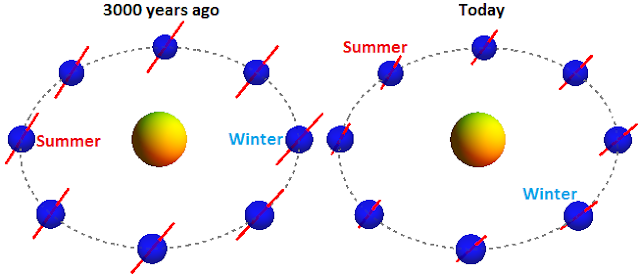This is literally ancient news. The usual dates for astrological signs were defined about 3,000 years ago. Each sign was named for the constellation that would be behind the sun at that time of year. But the sun is no longer in front of the same constellation as it was 3,000 years ago at the same time of year. The dates of the signs should have gradually shifted in a process known as the precession of the equinoxes.
But most astrologers don't use shifted dates. According to Wikipedia, this is because they emphasize the "symbolic or metaphorical meaning of the star signs". But I daresay that most people who read their horoscope simply don't know about the precession of the equinoxes. Myself, I think that the signs have no meaning at all, and the perceived accuracy of horoscopes is merely a testament to how similar our experiences are, or to the power of the Forer effect.
The precession of the equinoxes has to do with the "wobble" of the earth.
(Source: NASA)
The earth has an axis of rotation (in red), but this axis slowly moves in a circle (in white above the earth). This process is distinct from the spin and orbit of the earth. The earth spins around its axis once a day. It orbits around the sun once a year. The axis of rotation precesses in a full circle approximately every 26,000 years. Therefore, in 3,000 years, the axis of rotation has moved by more than one ninth of a full circle.
While a spinning object will continue to spin due to inertia, a precessing object needs some force to maintain the precession. Consider a gyroscope that we've set on a table.
(Source: Wikipedia)
The wobbling of the gyroscope is precession. In the case of the gyroscope, precession is caused by the weight of the gyroscope, as well as the force of the table holding it up. But the earth is not lying on a table. Instead, the precession of the earth is caused by the gravitational forces of the sun and moon. More specifically, it's caused by tidal forces, the same ones that cause the tides.
How does this affect the dates of the astrological symbols? It has to do with the tricky definition of a year. North of the equator, the start of each new year occurs some time in winter. Winter occurs when the Earth's axis of rotation is pointing away from the sun. But if the axis of rotation moves, that means that winter moves!
(original image; axial tilt exaggerated for clarity)
To make sure that our calendar keeps up with the seasons, we have a tricky definition of a year. A year is not the time it takes for the earth to orbit. A year is defined in such a way that it keeps up with the seasons. If we want to talk about how long it takes the earth to orbit, we call that a sidereal year, which is slightly longer than the year we normally use, the tropical year.
The thing is, winter moves around, but the constellations don't move much at all. That's why precession shifts the astrological signs.
But wait! Why do we have a new astrological sign, Ophiuchus? It turns out that the answer is far less scientific. Back in ancient times, when the dates of the astrological signs were solidified, astrologers divided the sun's path through the stars into twelve equally-spaced segments. Each of the twelve segments was assigned to a different constellation. But the fact of the matter is that these constellations are not equally sized. In fact, the "size" of a constellation isn't even very well defined, since what is a constellation but a set of stars that's supposed to look like something (but usually doesn't really).
Seriously, that does not look like a crab, even after you've drawn the imaginary lines.
This didn't do for the International Astronomical Union. So in 1930 they defined specific regions of the sky as belonging to different constellations. These regions are arbitrary, but hopefully less arbitrary than the regions defined by astrologers thousands of years ago. Using these definitions, the twelve astrological signs are no longer of equal length in the year, and the sun passes in front of a thirteenth constellation, Ophiuchus. (source)
And so if you were born between November 29 and December 17, your sign according to the IAU is Ophiuchus, the serpent bearer. The symbol is the Rod of Asclepius, a snake entwined around a staff. This almost makes up for Pluto!













0 comments:
Post a Comment